From Shooter to Shooter: The Rise of cly5m
Seiklus was a turning point for the indie scene. Even if you’ve never played it, you’ve played something influenced by cly5m’s game. Seiklus was one of the first “exploration platformers,†now a booming and distinctly indie genre. A small man, nearly a stick figure, travels a gentle flat-colored world, collecting pointless trinkets and the occasional control upgrade, to find his way back home again. There is no death, and no overt violence; Seiklus is all about the journey, and the player’s relationship with the game world.
Seiklus comes off as a very personal game. Although the controls amount to little more than walking and jumping, and the presentation is nearly as minimalist, the experience feels emotionally rich. Its level geometry and sequencing trade epiphanies for careful observation and experimentation, and the sound design creates a distinct and whimsical atmosphere.
The stripped-down expression of Seiklus has helped to legitimize canned game creation systems, leading Mark Overmars’ Game Maker to become the respected behemoth it is now, and lending the indie scene an entry-level spine. There have been tributes and parodies. It’s just an important game.
For all its influence, Seiklus is kind of a one-off. For a while creator cly5m and Robert Lupinek teased the Internet with Velella, a sort of spiritual successor involving dream flight. Otherwise, the last eight years have passed pretty quietly. The previous eight, though – that’s a different story.
The History of A-J Games: Part Four
To catch up on the story to date, you can view the archive here.
Between eighth grade and my sophomore year of high school was my phantom year. I wasn’t in public school, I wasn’t in private. Instead, I mostly sat at home and read books. This year corresponded with my 14th birthday, and with my introduction to Game-Maker. It was a year of untempered productivity.
I’ve talked about my early character-focused design. One of my early sources of characters was my former grade and middle school associates. After school or on weekends, they would come by to play videogames; I would drag them to the computer and show them what I was up to.

I think my games mostly puzzled them. They were sort of impressed that the games existed, but they didn’t much understand computers and were mystified by my subject matter and design choices. Inevitably, their minds would wander. They would ask me, could I make a game resembling this other game that they liked? Sure, maybe. I’d try. Could I put them in the game? Well… okay.

At that time, the big thing in my social circle (if that’s the term) was Japanese RPGs — Dragon Warrior, Phantasy Star — and PC strategy games like Star Control. They were also big into arcade brawlers and forced-perspective shooters. None of these genres was a match with Game-Maker, but I did what I could. Often, that wasn’t much.
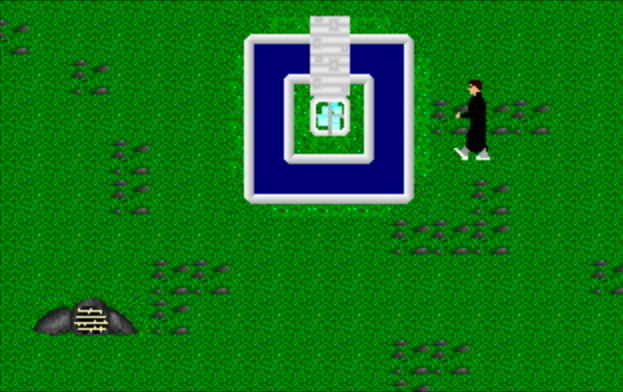
As the games were requests, I had little ego attachment. I threw them together out of available materials, as fast as I could. I based most of the characters on a standard template, tweaked a bit to resemble my clients. Background and other sprite elements, I borrowed from sample libraries and my own past games. As I churned out the requests, gradually I built up a sort of shared resource pool. Between those resources and some recurring themes, such as Groucho Marx, most of these other-insertion games feel very similar.
If I noticed the repetition, then I didn’t care; I had a job to do. It barely mattered if the games were playable, since they weren’t meant for me. If I could work in some clever references and then finish the project, I was satisfied. And then, on to the next request.
Distribution opened up another problem. As I said, I felt no attachment to the games. Although I felt obliged to release them, I didn’t want to mix this work for hire (as it effectively was) with my personal projects. I therefore devised a sub-label, Don’Pan Software, to aid in distancing myself.

I made no secret of the relationship between the two labels; it was just a mental thing. If it’s no good, don’t panic. It’s not supposed to matter. On this side of the line, you don’t have to care.
There are a few distinct eras and subcategories of insertion games. Right now I’ll just detail the first one, as they have more in common with each other than the rest of the games.
The requests started early. After A-J’s Quest, I think that Cireneg’s Rings may be my second game. It’s hard to be sure, but the more I consider it the likelier it feels. It would have to be early for me to tackle a project like this.
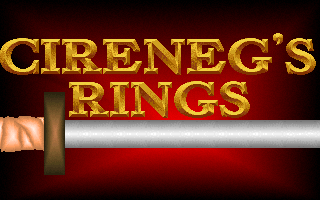
Cireneg’s Rings is an RPG in the tradition of Dragon Warrior, including a generic medieval setting, an evil overlord with a princess in captivity, sprawling towns hiding opaque yet important secrets, and a very slow-moving character.

There are a few subversions. You know the convention, popularized by Dragon Warrior, where exiting a city reduces it to the size of a single tile on the world map? The idea is that the journey between points of interest is heavily abstracted — both visually, in the representation of scale, and mechanically, in the random battles that represent personal trials and learning experiences on one’s journeys. In later JRPGs, the convention just becomes a convention: towns grow tiny, while a huge character walks around the map.
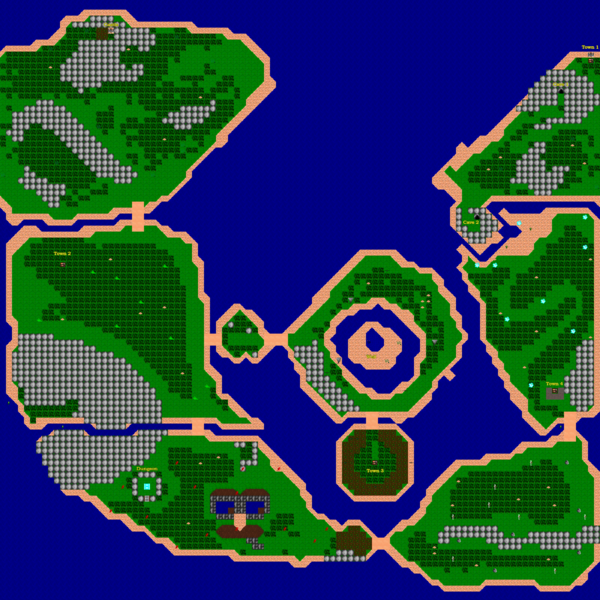
So I decided to play with that; whenever you leave a town, the game halts for a moment while your character erupts to an enormous size. This enormous character is then used to tromp the countryside between towns.

Other curiosities include the large “Groucho Rock” formation on the world map, a large healing sauna in each town, and — in early versions — lots and lots of nudity. That’s mostly gone now, though there may be a couple of incidental flashes hidden away. Even without the nudity, most of the townspeople are deliberately wonky. They stand in place and stomp or wave their arms, as townspeople do in games like this — except more so.

If any of this sounds clever, it’s more than offset by the inanity. The game, for instance, is filled with useless items such as armor, which often comes at a steep price. This is not so much commentary as an oversight; Game-Maker provides no way to raise or lower a character’s defenses, and yet I had to include the armor shop. Why? Because this was an RPG. Were I more astute, I could have turned the fact into a gag about in-game financing and genre conventions.

That is, I could have if Game-Maker if Game-Maker supported text overlays — which it didn’t, which probably should have given me pause before I attempted an RPG. Later on the engine got support for interstitial text and animation between levels. Although that made the premise a little clearer, it still left the player to wander aimlessly.

Not that it would have mattered, as at this point I had little concept of how to pace or structure a game. Even if you know precisely where to go and what to do, the smallest of tasks can take forever and the most important events can pass without a hint that something happened. There is no comprehensible flow from place to place, and no build-up or release of tension.
Just to make the continuity even stranger is my failure to account for Game-Maker’s lack of event flags or counter resets, meaning that in theory the player can re-enter a dungeon and collect ten copies of a priceless artifact, or continually leave and enter an area to collect a key or health upgrade. It’s kind of a mess.
On the plus side, Cireneg’s Rings is probably one of the biggest games designed with Game-Maker. I learned early what the game industry in general would take another ten years to figure out: if you can’t do quality, you can always make up for it with scale.

The moment I finished my first RPG, I turned that experience around and attempted another. Whereas Cireneg’s Rings was my take on Dragon Warrior, Linear Volume was a direct rip-off of Phantasy Star II — as close as I could manage.

When it came out, Phantasy Star II was in the range of $80-90 — and this was in 1980s money — so as big an impression as the game made on me, I never had my own copy. Instead, I borrowed the game for perhaps two years from a middle school associate. He was a year ahead of me and I didn’t know him all that well, but we had similar taste in games.

Around the time that I finally returned his game, I decided to make him a sort of thank-you gift. I whipped up a bad copy of the Motavian and Dezolian overworlds, and arbitrarily seeded them with towns and dungeons. I also designed an in-game intro, where a Winthrop Ramblers school bus disappears into a vortex and my acquaintance emerges into, essentially, the world of Phantasy Star II — albeit a version populated with Groucho noses, pickles, and toenail clippers.

When I told him what I was up to, my associate suggested a title and then asked if I meant to distribute the game commercially. If so, he insisted that I change the character’s likeness. This discussion sent a few wheels spinning, and led me to go back and produce a sanitized version of Cireneg’s Rings.
Previously I had given little thought to privacy or social delicacy. From here on, I had a sort of pattern for such games: one edition for the associate in question, and an edited draft for mass consumption. Any personal or gratuitously naughty elements went in the trash, to be replaced with random whimsy. That extra step gave the public editions more care and polish, which easily made them the definitive versions. It also made me feel less awkward about the games.
Around the time that I was wrapping up this project, a fellow who had played Cireneg’s Rings asked that I place him in a space adventure modeled in the vein of Star Trek. At the time I was only slightly familiar with The Next Generation, but a bit more cultured in space shooters and strategy games — in particular Toys for Bob’s Star Control.

Accolade’s Genesis port was another large and expensive cartridge that I had borrowed — twice the size of and possibly even more expensive than Phantasy Star II. It also loomed large in my creative mind, as the game was so darned strange. The cartridge was unlicensed, which meant the molding and the packaging were non-standard, and the actual game design was like nothing seen on a console at that time. Of especial note were the digitized sound effects, so uncommon at the time yet so easily implemented in Game-Maker.
After two wonky RPGs I was eager to try something different, so I set about designing a wonky shooter-adventure — with strong RPG trappings, mind you.
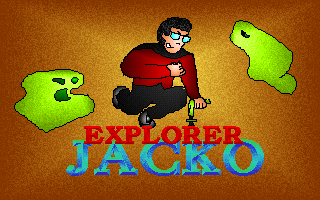
Ultimately, Explorer Jacko was only a slight departure from my earlier games. The way I figured, space would be the overworld — and space would be modeled on the melee mode of Star Control. This didn’t quite work out, but if one is charitable then the space levels might seem like a large-scale version of SpaceWar!, littered with almost pixel-for-pixel copies of some of the more interesting Star Control vessels.
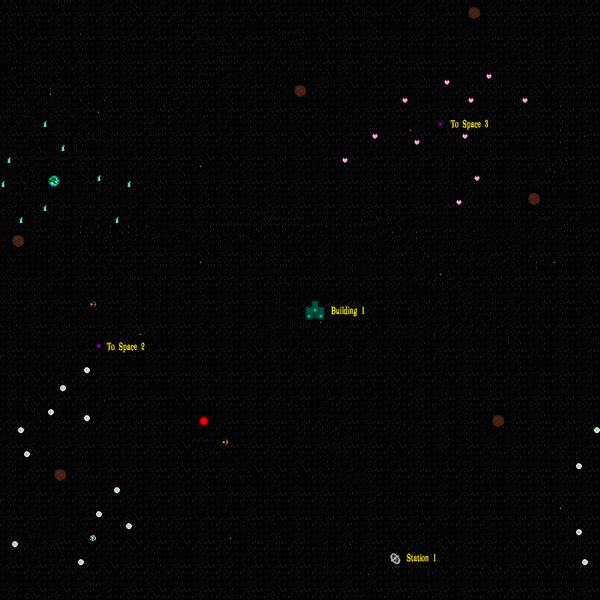
Being space, the overworld is very difficult to navigate. If you putter around long enough, you may come across towns or dungeons — or, if you will, space stations and derelict colonies. Deep Space 9 was the brand new thing in syndication; although I barely watched the show, that was probably an influence. Aside from serving as store fronts, the stations also contained holodecks that allowed for more adolescent mischief.

The player could also disembark at colonies to wander around on foot, shoot monsters, and collect important items. There was little real reason to do this except in pursuit of the game’s very simple, and distressingly imperialist, story. Hidden away in a dungeon, somewhere in space, is the passport that you need to land on a certain planet. Find the passport, then land on the planet. Bingo; you’re done.

The game’s entire challenge comes from the difficulty in finding one’s way, keeping track of where one has been, and in the severely overpowered ships and monsters that the player faces. In order to explore sufficiently to figure out what one is doing, one must destroy countless little monsters to rack up the money to upgrade both the ship and the character’s equipment.

Although the game is a failure in most respects, Jacko in a sense does more successfully follow the JRPG formula than its predecessors. It’s also a sort of interesting mix of play styles, with the constant cycle between a space shooter and an adventure exploration game. The game’s beginning, although poorly implemented, is also curious; the player starts by breaking out of a jail cell, and for a while has no direct means of attack or defense — just some time delayed explosives. Eventually the player finds a ship and, with luck, limps to a nearby space station for help.
Designed better, that might have been a dynamic teaser to draw the player into the game’s action while slowly introducing its concepts. As implemented, it just confuses the player with one irrelevant obstacle after another. Hey, live and learn.
I certainly never tried another RPG, though I had far more strange decisions to come.
The story continues in Part Five…
The History of A-J Games: Part Three
To catch up on the story to date, you can read the first two parts here and here.
So some of my characters, I spun out of existing projects. Others came about from that web of interests and in-jokes that brought about my Andrew-Jonathan strip in the first place. These characters are built of wholly abstract materials, which makes it all the harder to justify them in design terms.
It would be one thing to base a game on abstract concepts. That’s probably an ideal place to begin, actually; to take vague notions from life and to see how best to communicate those ideas through a framework of cause and effect. You only seldom see this approach; when you do, as in games like Passage or D2, or even Pac-Man, you end up with highly expressive, meaningful content.

To base a game not on concepts, but things — well, you’re always starting on the wrong foot. This is why there are so few excellent licensed games, and why genres and long-standing series tend to devolve into meaningless variations on a form. It’s why tech demos, although fascinating on a level, make such empty and tawdry exercises.
This may be why so few developers have made real use of the Nintendo Wii. Nintendo boiled some brilliant and progressive concepts down to a thing, which developers proceeded to use as a thing rather than explore for the concepts that it represented.

So it’s hard enough to build a game out of an established character. Imagine if that character itself is uncertain. Instead of A-J Bear to draw from, with all his built-in thematic trappings and influences and continuity, you have the vague idea of a hedgehog who is very, very British. Offhand you can throw together a few lazy pitches, but what are you basing those pitches on? Cultural preconceptions? Handy iconography? Are you going to just stop there, or are you going to examine those preconceptions and break down that iconography into something practical and representational?
Think that’s easy? How about a game based on a funny name combined with a meaningless catch phrase? Whoever the character is, this is his name and these are the words that he spouts whenever possible.
Though I’m certain meaningful projects have begun with less material, some tasks were too much even for the slapdash methodology and low artistic standards of my youth.
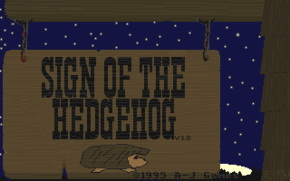
Considering its origins, Sign of the Hedgehog turned out pretty well. From its title you may ascertain my thought process. For full clarity, though, let’s take a trip back to 1991.
From a very young age, I was obsessed with hedgehogs. Such it was that when, in the early ’90s, I read of Sega’s upcoming mascot game, I felt compelled to tell the world. No one would believe me. I was obsessed with the Sega Genesis, which was fine but at that time no one owned or played the system. I was obsessed with hedgehogs, but in mid-Maine in the pre-Sonic era no one had ever heard of them except in association with me. So clearly I had gone off the deep end and was just making things up now.
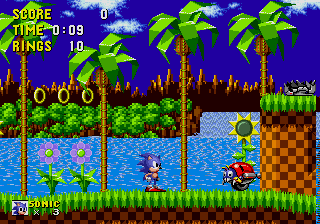
The game arrived, and it was very good, but — Sonic wasn’t really a hedgehog, was he. He didn’t look like a hedgehog, he didn’t move like a hedgehog, and he wasn’t really characterized the way you’d imagine. About the only parallels you can draw are that Sonic has spines and that he can roll into a ball. My mind got working.
Over the next couple of years, more Sonic games kept coming out to decreasing returns. Sure, each game had more stuff in it, but those were just things. The actual themes and spirit that made the first game so intriguing was being sidelined in favor of… stuff. It got so that Sonic the Hedgehog 3 was the last console game I bought or played until the Sega Dreamcast, another five years on. I was totally disenchanted with the direction that games were moving in.

And yet here I was in response, comporting more stuff into my own fetishistic ideas of propriety. I would draft my very own hedgehog game, the way that Sonic should have been. My hedgehog would of course be British, and as a Briton he would be enamored of all things tea. He would be reserved and conservatively dressed. As a hedgehog he would live in green places and only rarely stray out of his comfort zone. It would take a spectacular quest to shake him from his Hobbit-like indolence — something like a personal request from the Queen.

So we have a reluctant hedgehog with a tea obsession invited to see the Queen. What would motivate him to actually attend? Well, let’s make it tea with the Queen. What makes his journey an adventure? Maybe he needs to prepare for the visit. Let’s say he needs to bring supplies. What sorts of supplies? Goods for a tea party. So what goes with tea? If we’re being stereotypical, then crumpets.
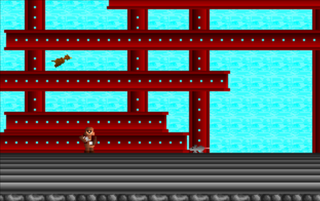
You can see the game taking shape here. Now we have a journey, and a scavenger hunt. Although there is a linear goal, this is a game about exploration and discovery rather than about speed (which is just as well for a hedgehog). Since it’s broadly linear but narrowly not, let’s scatter the levels around an overworld rather like Commander Keen‘s.
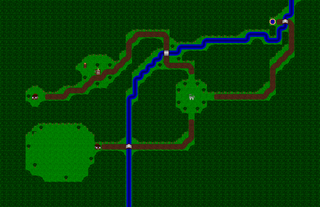
I’m not sure that this is very deep stuff, but at least the design concepts do come from the basic premise. If you squint, the game might even look a bit like satire regarding British conventions and the arbitrary decisions in mainstream game design. I don’t think any of that was deliberate. So far as I was aware, I made the game in earnest.
The game’s title is both a none-too-subtle nod to Sega’s game and a play on British public houses — or at least my adolescent concept of them.
In the end, Sign of the Hedgehog is more linear than I intended. You can thank those constant Game-Maker goblins of flags and counters. There was no easy way to prevent players from entering the same level over and over again to rack up provisions, which could only be a problem because Game-Maker will never reset special counters. Thus the player could keep collecting crumpets and 1-ups, dying, and then starting over to build up a wealth of currency and blow through the later levels.
Of course since the counters don’t reset this is a problem anyway, but at least making the level progression linear prevents players from abusing the system too terribly. In retrospect there are a few other unexplored solutions, but this is what we have.
The game was successful enough in my mind to warrant a sequel. I had promised one to registered users, and I figured that this time I would finally get a few orders. The orders never came, I got distracted by other projects, and the game never took shape.

To be precise, Sign of the Hedgehog 2 took a very general shape but I never bothered to whittle it down. As a result I have a slightly amended concept — this time Hedrick is collecting scones instead of crumpets; he now can toss crumpets like a Frisbee — and a new map screen, decorated with a poorly designed first level. To change things up, the map is now side-scrolling rather than an overhead view. You can tootle around the map all that you like, but there is nowhere to go.
One advantage to the side-scrolling map is that it does give a sense of scale and adventure. Compared to the bird’s eye view, you can judge how far Hedrick has traveled and what he went through to get there. I guess you could say it’s more subjective.

So far as I can tell, the one working level was more of a test than a real finished design. It consists of clear blocks against a night sky, presumably because I so enjoyed the clear blocks in the Commander Keen games. It was an easy visual effect, and it looked cool. Beyond that it had no purpose.
Already you can see my sensibility devolving, in several respects. But it would disintegrate much further.
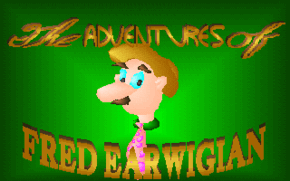
The Adventures of Fred Earwigian is the nadir of my character-based design process. By this point I had been hammering that character button for a couple of years, expecting my game concepts to magically present themselves at the last moment and allowing the full projects to take form. In this case, that didn’t happen. Why not? Well, let’s see.
Fred Earwigian was not so much a character as a wacky name. I have no memory of its origin; just that the name arose somewhere before high school, and thenceforth again whenever life called for a nom de guerre. Around my third year of high school, the name crossed paths with a domestic catch phrase and inanity was born.
On one return from Russia, my mother imparted a story of crossed communications. One of her hosts had advised her on departure not to forget, as she heard it, her hair. In reality he was speaking of a stuffed rabbit, a gift from one of her Russian friends. The misunderstanding delighted her enough to turn “Don’t forget your hair!” into a common goodbye in my household.

By 1994, my well of ready ideas was dry. I began The Adventures of Fred Earwigian with nothing but the name, and eventually a title screen, expecting intuition to steamroll the rest into existence.
Based on the title graphic, I figured that Fred was rather slow — both physically and mentally. In physique and mannerisms, I envisioned him as a vaudevillian yokel with bits of Charlie Chaplin and Groucho Marx. In personality, my mind went to Steinbeck’s Lennie, from Of Mice and Men. I wasn’t trying to be obscure; these were honestly my cultural references as a teenager. I didn’t get out much.
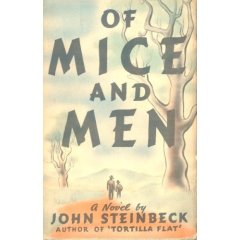
When one thinks of Lennie, one thinks of rabbits on the farm. When I thought of rabbits, I thought of Fred singing “Don’t fergetcha, don’t fergetcha hare / Ba-dum, ba-dum”.
That became the basis of my game: a bumbling, slow-moving, dim-witted fellow looking for a lost hare. I couldn’t make it work. I couldn’t find the game. I couldn’t find a point to it.
I drew and animated Fred’s sprite, and I recorded him some voice samples. I drew up half a dozen scenarios, none of which fit. The game was stalled.

I threw the character sprite and title screen together with a map and background tiles from one of RSD’s demo games, and uploaded the mess to the semi-official Game-Maker BBS in Rockport. With the files I included a document pitching Fred Earwigian as a design contest. Whoever made the best game out of the available materials would win something or other. No one bothered. Quite understandable.
You’d think that my experience with Fred Earwigian would have taught me something, but any wisdom was a good decade off yet. In the meanwhile I had mistakes to burn.
The story continues in Part Four…
The History of A-J Games: Part Two
To catch up on the story to date, you can read part one here.
The bulk of my Game-Maker career involved a backwards design process whereby I would think up a character, then write a story, then decide how to incorporate it all into a game. I built levels with little thought to the characters’ abilities or the game’s broader themes. I had that amateur notion that games were a battle of wills between the player and designer, so my games tended to be unfairly difficult. It was a mess.
Further confusing the issue was my process for choosing my characters. Life with my parents was like tap dancing in a mine field. Most of my energy was devoted to avoiding random triggers, which amounted to a sort of high-stakes guessing game. To keep in good graces, and thereby to be left to my ways, it was wise to run my activities past my mother and to leak details very slowly.
I recall that all of my pitches involved specific things, facts, that I thought would distract her. If nothing went click, and those gears failed to turn, it was safe to progress. Once, scrambling for an idea, I suggested a bear riding on a seahorse. I think that got a pass, but I couldn’t figure out how to spin a game out of it.
I had spun my first game from my comic, Andrew-Jonathan; that had been a success, both creatively and domestically, so for a while I kept returning to that mine. There was certainly enough to draw from. The world of my strip barely touched the page. It spanned a junkyard of irrelevant whimsies, from Easter toys to Apple Jacks prizes, wound together with half-remembered snatches of Susan Cooper novels.

One of the larger recurring themes is Cousin Zoom, a timid librarian with a prophetic name. For reasons unclear, Andrew-Jonathan’s grandfather is a wizard. Some wires crossed, his cousin found himself in the wrong place at the right time, and that cousin became a superhero.

Although Zoom gets the disguise right — he not only drops the Clark Kent spectacles; he dons a Zorro style mask — he keeps the same name in both guises. He also becomes a hazard to friend and foe alike.

Inspired by Taito’s Superman arcade game, I chose to do something a little different with RSD’s engine. I alternated side-scrolling action levels with overhead shooting segments, and I ramped the difficulty way down to make the game accessible.
The lower difficulty worked together with some new concepts to gloss over some of my earlier awkwardness. Flight removed the logical problems of platform mechanics, and a bulky sprite with full player control improved collision in the shooter levels. The engine was still awkward, but the game worked within its box.

Zoom cohered well enough that people seemed to actually play it. Although I have no metric, it looks like the most widely distributed of my games. Often listings would describe it as a children’s game, presumably because of the bear. That always confused me, as even with its lowered difficulty the game is still pretty tough.
Around the turn of the millennium Zoom turned up on a few major download sites. I recall that ZDnet gave it three stars out of five, which although unremarkable made me rather proud. By that point the game was five years old, running in a weird engine, and far from my best work — but someone who reviewed this stuff for a living still found it adequate. So, hey.
Some of the spin-offs are less obvious. Ralph, for instance, only made a single bizarre appearance in the comic, and in the game his backstory is very different to what I imagined elsewhere.

Ralph is an orphaned chicken-duck who dallies as a consulting detective. What complicates this task is that the only word he seems to speak is his own name. For the game I transplanted him to a world where all life forms are powered by precious green crystals, and gave him a range of surreal terrain to navigate in his search for a portal to Earth. Since Ralph was a detective, the mechanics were based around searching for objects and using a magnifying glass to focus beams of light at enemies.

Of all my Game-Maker games, Fluffy Ralph is probably closest to RSD’s intended use for its game engine. It’s a top-down, vaguely Zelda-like action adventure. There’s nothing complicated or subversive in the mechanics. Ralph was just a simple game to develop. I even borrowed many of the graphical elements from Zoom. Perhaps this lack of a struggle shows in the design, as compared to some of my other games very little feels out-of-place.

I’m unsure how far the game traveled, but I have received comments. It seems that people remember Fluffy Ralph, and remember it favorably. As usual the later levels become needlessly difficult, but presumably only a few have known that torment.

This next spin-off is a little harder to explain. Remember Wacky WallWalkers? I used to collect the things. To prevent them from drying out, I would preserve them in clear film canisters filled with dishwashing liquid. Somehow this turned into a running joke.

They were never exactly characters in the comic; more like a recurring concept. Yet I always felt empathy for the WallWalkers. They seemed sincere, with their huge eyes and startled expressions. The film tubes weren’t just a grotesquerie; I wanted to protect the Walkers from decay. This, I suppose, plays into the scenario of Octolris.

The game describes the titular hero as the last of the slime octopi; to avoid becoming soup, he embarks on a treacherous journey back to the sea. The levels he navigates make very little sense. He travels from an ambiguous green and purple area to the seashore, then to a disco. Between standard levels, Octolris explores tight mazes — storm drains, air ducts, plumbing.

The character can walk, leap in three directions, and climb up or down certain walls. The mechanics here are sort of unusual. Jumping is an all-or-nothing thing; when you press the key, you travel in a specific arc and land in a specific place. I wanted to address the weirdness of jumping in earlier games like A-J’s Quest, which encourages the player to spam the controls in order to glitch into higher and farther jumps. The mechanic works well; it’s just that I often fail to account for it in the level design, which makes some areas harder than necessary.
The other oddity is the wall-climbing. To reflect the way that Wacky WallWalkers lose their stickiness and slowly dry out, I chose to mete out the octopus slime. One problem with this idea is that, guess what, I failed to account for it in the level design — so if you run out of slime, you’re stuck. There is no other way to complete most levels. The other problem is that Game-Maker does not provide a display for special counters, and so the player has no way of understanding how much slime is left. I got around these problems by overwhelming the player with slime refills. Instead I should have just ditched the limit.
If you will, Octolris seemed to have more legs than many of my games. I see it pop up here and there, and I have gotten some positive feedback.
Despite their origins, all of these games pulled together fairly well — at least, by my standards of the time. Their designs did reflect key aspects of their concepts, and those concepts served to humanize the mechanics.
Probably their greatest asset is the shared background. Although by necessity I entered the design process through the wrong door, I had already thought about the characters and scenarios enough that there was at least a sense that I knew what I was doing. The result is that the games are a little more holistic than by rights they should be. The result of that is that they stick in the mind a little, and that people seem to have reacted fairly well.
The story continues in Part Three…
The History of A-J Games: Part One
If you have played Builder, you may wonder about the developer name tacked onto the front. The answer is that Builder puts official close to an era that previously I had left dangling for about fifteen years.

When I was young, I expected to be a cartoonist. From 1988 to 1992 I wrote and drew a spectacularly unfunny comic strip called Andrew-Jonathan. Although there was no particular story or humor, there were plenty of characters – all with complex relationships, backgrounds, and personality quirks. The strip was also an outlet for themes absorbed from adventure movies, Tintin and Uncle Scrooge comics, and personal experiences.

1988 was also the year that I began to design my first game, in the margins of homework assignments and in the back pages of notebooks. The game started as a clone of Konami’s The Goonies II — attic setting, inventory, and all. As the ideas developed and took on their own life, they absorbed elements of Hudson’s Adventure Island, Contra, and Super Mario Bros. 2. The cast of Andrew-Jonathan (in particular the title character) was also absorbed into the concept, almost from the start.

This imaginary game began to trickle back into both the text and the metatext of the strip. The Crabby monsters (likely a subconscious influence from Super Mario 2) started to appear.

The strip absorbed some of the game’s scenario, and the sort of violent 8-bit sense of cause and effect. Most curiously, whenever A-J’s friend Freeport was shown playing a videogame, it was a variant of that game –based on the strip and featuring those characters.

In a way, the strip’s four-year run was a build-up to and replacement for the game that I dreamed of playing. When in 1992 RSD’s Game-Maker presented itself, my attention shifted entirely from the comic. My first task on installing the software was to implement the game as directly as possible from my extensive plans. The result, I called A-J’s Quest. Barring the engine’s limitations and some improvisation along the way, the result was fairly close to my intentions – if a bit rough.

The biggest diversions came from the limits on idle states, the odd key-mapping restrictions, the engine’s strange treatment of counters, and the lack of an on-screen display for hit points, items, and whatnot. I also envisioned the ability to equip and unequip weapons, as in many NES adventure games. None of these were big problems; I just adapted, and found more pragmatic implementations.

Soon after completing the game, I responded to a note in the Game-Maker box and mailed a copy off to Recreational Software Designs. They quickly responded with an unexpected call, then a long correspondence that would eventually lead me to produce gameware for Game-Maker 3.0. More immediately, they sent me the beta to an upcoming release of Game-Maker – one with provisional Sound Blaster support. In turn I went out and bought a sound card.

The adjusted version of A-J’s Quest, now labeled 2.0, found its way into a demo for the 2.0 release of Game-Maker. It was also a feature of the short-lived Game-Maker Exchange program, where RSD compiled peer games onto floppies and sent them out to contributing users. But before I let loose my opus into the wider world, I decided to think up an official studio name. I didn’t think very hard.

Now that I was a real game designer, I started to pour my energy into developing a more-of-the-same sequel. Its main gimmick would be multiple characters, each of whom followed an original path to the same goal. To prepare for this focus, I redrew the character sprite almost from scratch. In a short time I had learned much of pixel animation, and the previous sprite had started to bother me. The new sprite, I used as the basis for all four characters.
Aside from appearance the characters were only really distinguished by their vocal tics, which the new Sound Blaster support made possible. The levels were mostly recycled themes, using recycled tiles from the first game.

A couple of years later, with a beta of Game-Maker 3.0 in hand, I set about making the biggest, most convoluted game possible with the tools. I meant to incorporate every possible character from the Andrew-Jonathan strip, each of whom would have distinct abilities and a different path through the game. The game would be a huge, branching adventure full of big decisions. For this event, I again tweaked the Andrew-Jonathan sprite with more detailed shading and more sympathy to Game-Maker’s quirks. In turn I added more variation to the other characters’ animations.

With my masterpiece in hand, I went back to revise the first two games and raise them to the level of A-J 3. I incorporated the second game’s much cleaner sprite into the first game. I adjusted most of the background tiles and some of the layout, added another level to A-J’s Quest, and smoothed over some awkward concepts. After all the tweaks, the first game wound up at version 4.0 and the second game wound up in pieces all over the hard drive. It was too much work to bring The Return of A-J up to snuff, and I had long overwritten its original format, so I was stuck with a dissected husk of a game. I figured if anyone actually registered the first game, then that would motivate me to put all the pieces back together. Neither happened.

Both the 4.0 and the 2.0 releases of A-J’s Quest achieved fairly wide distribution. The others, not so much. Whatever its form, for all its quirks and compromises, A-J’s Quest is probably one of the most familiar and influential games to come out of RSD’s tool set — and it became the cornerstone for about a decade of my creative life.
The story continues in Part Two…
Breaking the Frame
I just realized how much Builder was subconsciously influenced by Portal. I honestly didn’t even think about it at all. But Valve’s design pervades almost everything about the game’s structure, down to the build/destroy thing (as opposed to red/blue portal stuff), and the way that the design is broken down into… sort of puzzle rooms.
And the whole game is sort of about escaping from this cozy gamey situation. And all the way the game teases you about what may be beyond that facade. Then at some point you — well. At some point everything becomes clear, and that’s when things become really interesting.
It says something about Valve’s design sensibility that I find myself aping it without even knowing I’m doing so.
If you have yet to play Builder, go and do so. If you downloaded it early on, you might as well upgrade; there are always little improvements. Meanwhile I’m working on a way to make the game easier for everyone to experience.
The Game-Maker Archive – Part 20: Blinky and a Small Kind of Fame
Jeremy LaMar is perhaps best known under the handle SnigWich, for his Megazeux games such as Bernard the Bard – often ranked amongst the best games ever produced under Gregory Janson’s engine. More recently, under his new name Otto Germain, he has returned to his roots as a cartoonist. Before any of that, he was renowned for his RSD Game-Maker work – and he never even knew it.
At some point two of LaMar’s early Game-Maker games, The Return of Blinky and Blinky 3, made their way to a section of America Online known as AOL Kids. There, they gained a small yet fervent cult following. In the following years, a Blinky wiki and fanfics and video tributes would spring up around the Web. Even years after the AOL Kids area vanished, LaMar’s fans kept up the devotion. At least one poster to a DOS games forum claimed that the Blinky games inspired him to pursue game design.
When you consider the obscurity of most Game-Maker games, indeed of Game-Maker itself, this level of enthusiasm is remarkable. To be sure, LaMar’s games are amongst the most polished produced with RSD’s tools, both in terms of the design sensibility and in their mastery of the materials available to them. One does wonder, though, how much circumstance and exposure play in a game’s fortunes. One also wonders what other small communities might even now be obsessing over even less likely games, and to what extent those players might be inspired to greater things.
The Game-Maker Archive—Part 19: Presents and Protocol
There were three main ways that Game-Maker users communicated. Either they knew each other in person, which was nothing unusual but could lead to larger and more nuanced projects than an individual could tackle, they communicated through the post, which was slow but both mysterious and intimate, or there were the BBSes.
Before the Web caught on (or even existed), the big deal was local dial-up boards. Most of them were text-based, and most were fairly slow. You would connect, check your personal messages, see if anyone had posted any new discussion topics or responses, perhaps fiddle with a multiplayer door game or two — and then you would head to the file area.
Most boards had a ratio: you can download so many bytes for so many bytes you upload. A bad ratio was close to 1:1. Somewhere between a 2:1 and 4:1 ratio, the file area would come to life. Users would be just motivated enough to keep sharing material, yet wouldn’t feel pressed to dump just any junk on the community. This is the environment where shareware thrived; when the Web took over, the whole shareware model went into whack.
If you found the right board, BBSes were also the perfect environment to share and discuss Game-Maker games. Mark Janelle ran the Frontline BBS with RSD’s semi-official blessing. Other users ran their own boards or carved out corners of existing communities.
A problem with BBSes was their dial-up nature. Unless the board was very local, you were in immediate danger of old-school long distance phone charges. If the board was in the same state but not in the same county, you were particularly screwed. So despite Janelle’s and RSD’s efforts there was never a unified Game-Maker community. Rather, the community consisted of countless islands of independent development, that would occasionally cross paths and trade ideas.
Although it was located in the middle of nowhere — specifically Kennebunkport, Maine — which must have made a daunting long-distance charge for most users, the Frontline BBS was the most prominent place for these paths to cross. That makes sense; it was the only board referenced in the Game-Maker box. The board therefore carried some valuable artifacts of shared Game-Maker culture. Whether or not those artifacts are in themselves excellent is sort of beyond the point. What’s important is that they are formative and sort of iconic to the Game-Maker experience.
These four games, by two authors, are amongst the first Game-Maker games that many users will have played, aside from RSD’s demo games and those users’ own creations. Unfortunately not all of them still exist in precisely their original form, but one takes what one can get.
The Game-Maker Archive—Part 18: Call and Response
Back in July we unearthed two previously unknown Game-Maker games, Roland Ludlam’s space racer Hurdles and Matthew Groves’ free-roaming space shooter Space Cadet. We then tracked down and interviewed those two authors. Roland Ludlam is currently working on a WiiWare project and Matthew Groves is considering Android development; each was generous with his time and memories, and with some prodding each was generous enough to find and forward some other long-neglected projects for us to record and archive. The former scrounged around on an old backup of a backup, and the latter mailed us a collection of 5-1/4″ floppies to extract.
From each party we received two games: one fully developed and substantial, and one experimental or unusual. We’ll start with the “big” games, and then once we’re primed we’ll turn to the really interesting stuff.
Lost in Space with Matthew D. Groves
A few months ago we detailed some search methods for discovering unknown Game-Maker games in the wild Web; as examples we detailed two games: Roland Ludlam’s rather wonderful Hurdles, and Matthew Groves’ modestly charming Space Cadet. Since our interview with the one author went so well, we now turn our sights on the second, Web developer and aspiring Android coder Matthew D. Groves.
The Brussels Spout (Book 2)
The Martins and their burgeoning demo group known as PPP Team seized Recreational Software Designs’ Game-Maker with a ferocity and a measured European flavor of design. Over two or three years they assembled upwards of 24 games, each more ambitious than the last. Since they were developing with an unlicensed copy of Game-Maker, most of those games were strictly for their own entertainment — which may to some extent explain the energy that went into them.
There are three branches of PPP Team software. In our previous article we discussed their one-off, often experimental titles. These games tend to be both character driven and strongly inspired by Commodore and shareware design sensibilities. One of those games, Blork Carnage, introduces a character named Jack Booster. This game and this character serve as the roots for the second of PPP Team’s branches — their defining franchises.
If the one-off games housed a wealth of interesting whims, it’s PPP Team’s series that received the bulk of their effort and originality. Of those, both the most significant and the most varied series are spun off from the Duke Nukem styled Blork Carnage. A third, early series also showed itself during the team’s Game-Maker era, to further build off one of those spin-offs. We’ll start with the series that more or less equates with PPP Team, in terms both of iconography and of their design sensibility.
HECHO EN PUERTO RICO !!!
News bulletin. Angelo Felix named his game Shanna after his daughter. No wonder the game is so adorable.
Xferplay
You may have noticed a large number of articles over the past few months devoted to Recreational Software Designs’ Game-Maker. I’m not sure why, after all this time, I hit on the topic, but with this one-track mind of mine it’s a thread I’m compelled to follow as far as it will go. First we’ve got the individual articles on DIYGamer, which tend to take a few games or a sub-topic and spin a message out of them. Then, for the sake of organization, I crack apart the articles and distribute the elements around my wiki (usually rewritten a bit). The wiki began as a way for me to keep track of what I’ve written about what, and has begun to develop some substance of its own.
As part of the process, I’ve also begun a bit of detective work. I have tracked down and contacted about half of the Game-Maker users that I’m aware of, and have leads on a few more. Sometimes the trail has led me to previews of new Wii games; sometimes to complex worlds of fiction. Mostly, it has led me to a wall of bewilderment. And the odd new game to add to the list.
Although I’ve still a bunch of authors to find, I think my shortlist consists of The Descent author David Barras, Shanna author Angelo Felix, Paper Airplane author Matt Bell (with whom I did exchange some letters in the mid-1990s), Firefall author Firefall Softwarez (whoever that may be), Woman Warrior author Sheldon Chase, and Flying Guts author Marty Valenti. I don’t know how wide or deep these posts go, but if anyone knows how to get in touch with one or more of these people, drop me a line.
Likewise, if anyone has, or knows where to find, a copy of any of these games, I’m sure that their authors would be as appreciative as I.
And hey, maybe future generations will appreciate the conservation. Or maybe not. Darned kids.
Roland Ludlam on Liight and the Hurdles of Game-Making
Following our interview with Orb author Joshua Turcotte, we turn our information thresher to another isolated game, the closest that Game-Maker ever got to a respectable scrolling shooter, Hurdles. The game is short on presentation and deep in ingenuity; it does what it sets out to, and then moves on. To contrast with that focus, its author Roland Ludlam is something of a polymath: hacker, musician, illustrator, photographer, poet.
Most recently, Ludlam has co-founded a small game design company, Studio Walljump, with the aim of producing a new puzzle-music game for WiiWare. We caught him with a dual-edged interview; come for the moldy game, and get a preview for the bargain.